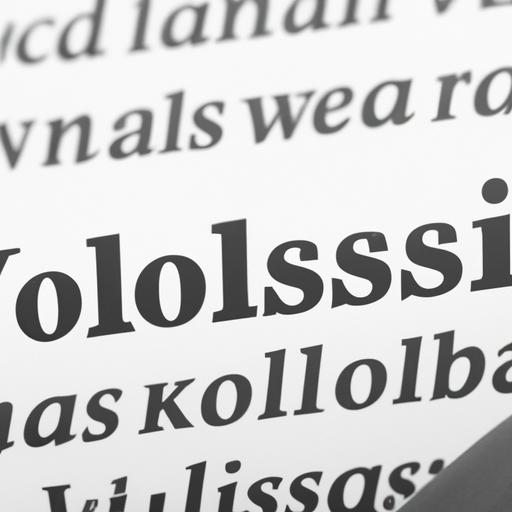Okay, okay. We get it. You’re confused about how to spell “okay”. Is it okay? Absolutely. After all, we’ve all been there at some point. Whether you’re a native speaker or just learning the ropes of the English language, the spelling of “okay” can be a bit perplexing. But fret not, dear reader. In this article, we’ll clear up all the confusion and provide you with the ultimate guide on how to spell “okay” correctly once and for all. So let’s dive in and put this spelling conundrum to rest.
1. Getting it Right: How to Spell “Okay”
– “Okay,” “OK,” “O.K.,” or “ok”? What is the right way to spell this word? The spelling of “okay” has been a subject of debate for a long time. In this post, we will explore the different ways to spell “okay” and discuss which one is the most appropriate.
– First of all, it’s important to note that all four spellings are acceptable in English. The most common spelling is “okay,” which is also the one recommended by the Oxford English Dictionary. However, “OK” and “O.K.” are also widely used, especially in informal contexts such as text messages, emails, and social media posts.
– The origin of “okay” is unclear, but it’s believed to have first appeared in the United States in the mid-19th century. Some theories suggest that it comes from Native American languages, while others link it to African American dialects. Regardless of its origins, “okay” has become a ubiquitous word in English and is now used all over the world.
– So, which spelling should you use? The answer depends on the context and your personal preference. If you’re writing a formal document or academic paper, it’s best to use “okay,” as it’s the most widely accepted spelling. However, if you’re writing an email to a friend, using “OK” or “O.K.” is perfectly fine.
– It’s worth noting that some style guides recommend different spellings for different contexts. For example, The Chicago Manual of Style recommends using “okay” in most cases but suggests using “OK” for headlines or titles. The AP Stylebook, on the other hand, always uses “OK” without periods.
– Another thing to consider is the pronunciation of “okay.” In some dialects, it’s pronounced as “o-key,” while in others it’s pronounced as “oh-kay.” This can affect your choice of spelling, as “OK” may be more appropriate if you’re going for the “o-key” pronunciation.
– In conclusion, there’s no one right way to spell “okay.” All four spellings are acceptable in English, and the choice depends on the context and your personal preference. When in doubt, go for “okay,” as it’s the most widely accepted spelling. But don’t be afraid to use “OK” or “O.K.” if the situation calls for it. Just make sure to be consistent throughout your writing.
2. Alright, Alright, Alright: The Proper Spelling of “Okay”
When it comes to spelling the word “okay,” there seem to be endless possibilities. Some spell it as “ok,” while others prefer “okay” or “o.k.” So, which one is right?
The answer is actually quite simple: they’re all correct. According to the Merriam-Webster dictionary, the most widely accepted spelling is “okay,” but “ok” and “o.k.” are also acceptable alternatives.
So where did these different spellings come from? Well, it turns out that “okay” has been around for quite some time. The word is believed to have originated in the United States in the 1830s and was initially spelled as “oll korrect,” a playful misspelling of “all correct.”
Over time, “oll korrect” was shortened to “ok,” which eventually became the widely accepted spelling. However, “okay” remained a popular option and is now considered the standard spelling.
As for “o.k.,” it’s believed to have emerged in the late 19th century as a way to save space in telegrams. The periods were added to signify that there were only two letters in the word, making it easier to count the number of words in the message.
Regardless of how you choose to spell it, “okay” has become a ubiquitous part of the English language. It’s used to indicate agreement or acceptance and can also be used as an adjective to describe something that’s satisfactory or acceptable.
If you’re still unsure which spelling to use, it’s always a good idea to consult a dictionary or style guide. And remember, while there may be different ways to spell “okay,” the meaning remains the same.
In conclusion, the next time you’re wondering which spelling of “okay” to use, rest assured that there’s no wrong answer. Whether you prefer “okay,” “ok,” or “o.k.,” you can confidently use it to indicate agreement or acceptance.
3. No More Guessing: The Correct Way to Write “Okay”
Have you ever found yourself questioning how to spell “okay”? You’re not alone. The word “okay” is so commonly used in everyday language that it’s easy to overlook the correct spelling. But fear not, we’re here to clear up any confusion.
First things first, it’s important to note that “okay” is the standard spelling in American English. In British English, “okay” is acceptable, but “OK” is more commonly used. However, both spellings are widely recognized and accepted in both dialects.
Now, let’s dive into the nitty-gritty of properly writing “okay.” One common mistake is using “ok” or “O.K.” While these variations may seem like a shortcut, they’re actually incorrect. To avoid this error, always use “okay.”
Another thing to consider when writing “okay” is capitalization. The general rule of thumb is to capitalize the first letter in a sentence or when used as a formal greeting. For example, “Okay, let’s get started.” However, when used in casual conversation or informal writing, it’s acceptable to write it in all lowercase: “I’m okay with that.”
In addition to proper capitalization, it’s essential to consider context. For instance, if you’re writing a formal email or letter, it’s best to avoid using “okay” altogether. Instead, use more appropriate language such as “confirmed” or “acknowledged.”
It’s also worth noting that “okay” is not the only way to express agreement or approval. There are several alternatives that could be a better fit depending on the situation. For example, “alright,” “fine,” or “understood” can all be used in place of “okay.”
In summary, the correct way to write “okay” is with both letters in lowercase. Avoid using shortcuts such as “ok” or “O.K.” and consider the formality of the situation before including “okay” in your writing. And when in doubt, remember that there are alternative phrases you can use to express agreement or approval.
4. To “O.K.” or Not to “O.K.”? Breaking Down the Spelling of “Okay”
When it comes to the commonly used expression “okay,” many people may be unsure of its correct spelling. Is it “okay” or “o.k.”? And where exactly did it come from?
Firstly, it’s important to note that both spellings are correct. The spelling “okay” is considered the more widely accepted and modern version, while “o.k.” is an older form that has fallen out of fashion but is still used in specific contexts, such as formal writing.
The origin of the term “okay” is a bit murky, with several theories floating around. One popular theory is that it comes from the Native American Choctaw word “okeh,” which translates to “it is so.” Another theory is that it’s an abbreviation of the phrase “oll korrect,” which emerged as a humorous misspelling of “all correct” in the 1830s.
Regardless of its origins, the term “okay” has become one of the most versatile and widely used expressions in English, with a range of meanings and uses depending on the context. Here are just a few examples:
– To indicate agreement or approval: “Are we still on for dinner tonight?” “Okay, sounds good to me.”
– To express acknowledgement or understanding: “I know it’s a busy time for you, but could you let me know when you have a chance to meet?” “Okay, will do.”
– To signify compliance or permission: “Can we bring our dogs to the park?” “Okay, but make sure they’re on a leash.”
– To convey a sense of resignation or acceptance: “I didn’t get the job, but okay, I’ll just keep looking.”
Overall, the term “okay” is a versatile expression that has stood the test of time, despite its somewhat unclear origins and slightly variable spelling. Whether you prefer “okay” or “o.k.,” there’s no denying that this term has become an indispensable part of the English language, used by millions of people every day in a wide range of contexts.
5. The Ultimate Guide to Writing “Okay” Correctly
It’s a common mistake to use the word “okay” interchangeably with phrases like “alright,” “fine,” and “good.” But if you’re looking to communicate effectively in written communication, it’s essential to understand how to use “okay” correctly.
First and foremost, it’s important to note that “okay” is a colloquial word. If you’re writing something that requires a formal tone or if you’re unsure whether its usage is appropriate, avoid using it altogether. Additionally, the word “okay” is typically used to indicate acceptance or agreement; it should not be used to indicate enthusiasm or excitement.
There are several ways to spell “okay,” each with its pronunciation and connotations. The most common spelling is “okay,” but it’s also frequently spelled “ok” or “o.k.” While all three spellings are correct, using “okay” is the preferred option for written communication.
It’s worth noting that the word “okay” can also be used as an adverb to indicate something is satisfactory or acceptable. For example, “The food is okay” or “I’m feeling okay.” When used in this way, “okay” warrants no further elaboration. If you’re looking to add detail to your statement, consider using different adverbs like “good,” “fine,” or “well.”
Finally, it’s essential to use “okay” in the right context. It’s not always appropriate to use it to respond to a question, for instance. Instead, use “yes” or “no” to respond to a yes-or-no question. Similarly, “okay” is not a substitute for “thank you.” If someone has done something kind for you, it’s always a good idea to express your gratitude sincerely.
In conclusion, using “okay” correctly in written communication may seem like a minor detail, but it can impact the clarity and effectiveness of your writing. By keeping these guidelines in mind, you’ll be able to use “okay” correctly and convey your intentions more effectively than ever before.
6. Say It with Confidence: Mastering the Spelling of “Okay”
When it comes to spelling the word “okay,” some people fret and fumble, while others have it down pat. If you’re in the former group, don’t despair! With a bit of practice and some helpful tips, you too can master the spelling of “okay” with confidence.
Firstly, let’s address some common misspellings that you’ll want to avoid:
– “Ok” is not the same as “okay.” The latter is the correct spelling, while the former is an abbreviation that’s best avoided except in informal contexts.
– “O.K.” and “o.k.” are also acceptable spellings, but they’re more old-fashioned and formal than “okay.” Be aware that some style guides may not allow them, so check your context carefully.
– “Okie dokie” and “okeh” may be cute or quirky, but they’re not standard spellings of “okay.” Use them sparingly and with caution.
So, how can you remember the correct spelling of “okay”? Here are some tips:
1. Break it down: “Okay” is made up of two parts: “o” and “kay.” Think of it as “oh, kay!” to help you remember the spelling.
2. Picture it: Try to visualize the word in your mind’s eye. This can help you see the correct spelling more clearly and commit it to memory.
3. Associate it: If you’re a visual or auditory learner, try to associate “okay” with something that sounds or looks similar. For example, you might think of “ocean” for the “o” sound and “kite” for the “kay” sound.
4. Pronounce it: Sometimes, saying a word out loud can help you remember how to spell it. Practice saying “okay” with confidence and clarity.
5. Write it down: Practice writing “okay” several times until it becomes second nature. You might even try writing it in different fonts or styles to help it stick in your mind.
No matter which method you choose, remember that spelling takes practice and patience. Don’t beat yourself up if you make mistakes – just keep trying! With these tips, you’ll soon be spelling “okay” with confidence and ease.
7. Don’t Be a Spelling Rookie: How to Write “Okay” Like a Pro
Spelling “okay” might seem like a simple task, but it’s easy to slip up and make a mistake. To make sure that you write “okay” like a pro, here are a few tips to keep in mind.
Firstly, remember that “okay” can be spelled in different ways. While the most common spelling is “okay,” you might also see it spelled as “OK,” “O.K.,” or even “ok.” However, it’s important to note that some of these alternate spellings might not be considered correct in all situations. For example, “OK” might be more commonly used in informal contexts, while “O.K.” might be preferred in more formal situations.
When spelling “okay,” pay attention to the capitalization. In most cases, “okay” should be written in all lowercase letters. However, if you’re using “OK” or “O.K.,” these should be capitalized. Additionally, if “okay” is the first word in a sentence, it should be capitalized as well.
Another important thing to keep in mind when spelling “okay” is to avoid using unnecessary letters. For example, you might see “okey” or “okeh” spelled instead of “okay,” but these are not the correct spellings. Using these alternate spellings can make your writing look unprofessional or even uneducated.
If you’re unsure about the correct spelling of “okay,” it’s always best to check a dictionary or style guide. This can help you ensure that you’re using the correct spelling for the context in which you’re writing.
In addition to paying attention to spelling, it’s also important to consider the meaning of “okay” when using it in a sentence. “Okay” can be used to indicate agreement or approval, but it can also be used as a way to acknowledge something without expressing any particular feeling one way or the other.
By following these tips, you can write “okay” like a pro and avoid any rookie spelling mistakes. Whether you’re writing a formal business email or a casual text message, paying attention to spelling and using the correct spelling of “okay” can help you come across as professional and knowledgeable. In conclusion, whether you spell it as “okay” or “ok,” one thing is certain – this short, simple word has made its way into our everyday vocabulary, and is here to stay. With its versatility to express acceptance, agreement, or even indifference, the spelling of “okay” may vary depending on the context and preference of the writer. But in the end, it’s not the spelling that matters, but the meaning conveyed by this ubiquitous word. So next time you find yourself wondering how to spell “okay,” just remember – as long as it gets the message across, it’s all good.



